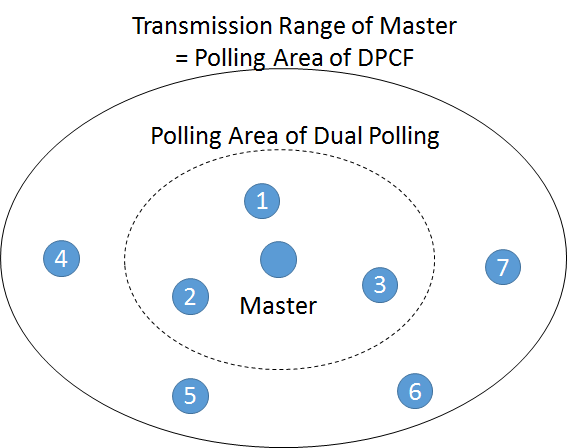Dual Polling Protocol for Improving Performance in Wireless Ad Hoc Networks
Keywords:
collision, dual polling, fairness, hidden terminalAbstract
An ad hoc network is based on a distributed coordination function (DCF) to transmit data packets through channel contentions. In DCF, when the number of stations increases, performance degrades considerably because of extremely high collision probability. To improve performance, a distributed point coordination function (DPCF) protocol was proposed. In this protocol, stations operate as in DCF to obtain channel access rights. When a station obtains access rights, it polls all neighboring stations by using point coordination function (PCF). The polled stations then transmit their data packets without channel contentions. However, this protocol aggravates the issue of hidden terminals and causes channel wastage. To solve these problems, we propose a protocol in which a station polls stations in limited areas as opposed to every station in its transmission range. In addition, it polls only stations with data packets. The proposed protocol lowers the probability of collision and improves network performanceReferences
K. H. Almotairi and X. Shen, “A distributed multi-channel MAC protocol for ad hoc wireless networks,” IEEE Transactions on Mobile Computing, vol. 14, no. 1, pp. 1-13, January 2015.
K. Hafeez, L. Zhao, J. Mark, X. Shen, and Z. Niu, “Distributed multichannel and mobility aware cluster-based MAC protocol for vehicular ad-hoc networks,” IEEE transactions on vehicular technology, vol. 62, no. 8, pp. 3886-3902, October 2013.
IEEE 802.11 working group, “Wireless LAN medium access control (MAC) and physical layer (PHY) specification,” IEEE September. 802.11, 2012.
D. Basu, G. S. Gupta, G. Moretti, and X. Gui, “Performance comparison of a new non-RSSI based wireless transmission power control protocol with RSSI based methods: experimentation with real world data,” International Journal of Engineering and Technology Innovation, vol. 6, no. 1, pp. 30-54, January 2016.
P. C. Ng and S. C. Liew, “Throughput analysis of IEEE802.11 multi-hop ad hoc networks,” IEEE transactions on networking, vol. 15, no. 2, pp. 309-322, April 2007.
H. Xu and L. Lei, “A MAC protocol based on busy tone for ad-hoc networks with beamforming antennas,” Proc. international conf. systems and informatics (ICSAI 2016), IEEE Press, January 2016.
Q. Ye, W. Zhuang, L. Li, and P. Vigneron, “Traffic-load-adaptive medium access control for fully connected mobile ad hoc networks,” IEEE transactions on vehicular technology, vol. 65, no. 11, pp. 9358-9371, November 2016.
J. Alonso-Zarate, E. Kartsakli, L. Alonso, and C. Verikoukis, “Performance analysis of a cluster-based MAC protocol for wireless ad hoc networks,” EURASIP journal on wireless communications and networking, vol. 2010, pp. 1-16, March 2010.
J. Alonso-Zarate, E. Kartsakli, A. Cateura, C. Verikoukis, and L. Alonso, “A near-optimum cross-layered distributed queuing protocol for wireless LAN,” IEEE wireless communications, vol. 15, no. 1, pp. 48-55, February 2008.
Q. Ye, W. Zhuang, L. Li, and P. Vigneron, “Traffic load adaptive medium access control for fully-connected mobile ad hoc networks,” IEEE transactions on vehicular technology, vol. 65, no. 11, pp. 9358-9371, January 2016.
D. Moad, S. Djahel, and F. Nait-Abdesselam, “Padovan sequence based backoff algorithm for improved wireless medium access in MANETs,” Proc. global information infrastructure and networking symposium (GIIS), September 2014, pp. 1-6.
Q. T. Hoang and X. N. Tran, “Improved cross-layer cooperative MAC protocol for wireless ad hoc networks,” Proc. Signal and Information Processing Association Annual Summit and Conference (APSIPA), December 2014, pp. 1-6.
H. H. Chin, C. C. Lin, and D. J. Deng, “Contention resolution algorithm for MAC protocol in wireless ad-hoc networks,” Proc. Wireless Communications and Mobile Computing Conference (IWCMC), August 2012, pp. 856-859.
J. P. Sheu, J. T. Chang, C. Ma, and C. P. Leong, “A cooperative MAC protocol based on 802.11 in wireless ad hoc networks,” Proc. Wireless Communications and Networking Conference (WCNC), April 2013, pp. 416-421.
H. Saggar, Y. Jiang, B. Daneshrad, and G. Pottie, “A concurrent CSMA MAC protocol for mobile ad hoc networks using beamnulling,” Proceedings of Military Communications Conference (MILCOM), October 2015, pp. 97-102.
R. Zhang, L. Cai, and J. Pan, “Performance study of hybrid MAC using soft reservation for wireless networks,” 2011 IEEE International Conf. Communications (ICC), IEEE Press, July 2011, pp. 1-5.
R. Zhang, L. Cai, and J. Pan, “Performance analysis of reservation and contention-based hybrid MAC for wireless networks,” 2011 IEEE International Conf. Communications (ICC), IEEE Press, July 2010, pp. 1-5.
W. Hu, H. Yousefi’zadeh, and X. Li, “Load adaptive MAC: a hybrid MAC protocol for MIMO SDR MANETs,” IEEE transactions on wireless communications, vol. 10, no. 11, pp. 3924-3933, November. 2011.
J. Alonso-Zarate, C. Crespo, C. Skianis, L. Alonso, and C. Verikoukis, “Distributed point coordination function for IEEE 802.11 wireless ad hoc networks,” Ad hoc networks, vol. 10, no. 3, pp. 536-551, May 2012.

Published
How to Cite
Issue
Section
License
Copyright (c) 2017 International Journal of Engineering and Technology Innovation

This work is licensed under a Creative Commons Attribution-NonCommercial 4.0 International License.
Copyright Notice
Submission of a manuscript implies: that the work described has not been published before that it is not under consideration for publication elsewhere; that if and when the manuscript is accepted for publication. Authors can retain copyright in their articles with no restrictions. Also, author can post the final, peer-reviewed manuscript version (postprint) to any repository or website.

Since Jan. 01, 2019, IJETI will publish new articles with Creative Commons Attribution Non-Commercial License, under Creative Commons Attribution Non-Commercial 4.0 International (CC BY-NC 4.0) License.
The Creative Commons Attribution Non-Commercial (CC-BY-NC) License permits use, distribution and reproduction in any medium, provided the original work is properly cited and is not used for commercial purposes.



.jpg)


